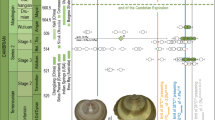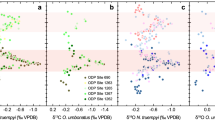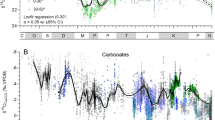Abstract
To understand the climate dynamics of the warm, equable greenhouse world of the Late Cretaceous period, it is important to determine polar palaeotemperatures. The early palaeoceanographic history of the Arctic Ocean has, however, remained largely unknown, because the sea floor and underlying deposits are usually inaccessible beneath a cover of floating ice. A shallow piston core taken from a drifting ice island in 1970 fortuitously retrieved unconsolidated Upper Cretaceous organic-rich sediment from Alpha ridge1,2,3,4, a submarine elevated feature of probable oceanic origin5. A lack of carbonate in the sediments from this core has prevented the use of traditional oxygen-isotope palaeothermometry. Here we determine Arctic palaeotemperatures from these Upper Cretaceous deposits using TEX86, a new palaeothermometer that is based on the composition of membrane lipids derived from a ubiquitous component of marine plankton, Crenarchaeota6. From these analyses we infer an average sea surface temperature of ∼15 °C for the Arctic Ocean about 70 million years ago7. This calibration point implies an Equator-to-pole gradient in sea surface temperatures of ∼15 °C during this interval and, by extrapolation, we suggest that polar waters were generally warmer than 20 °C during the middle Cretaceous (∼ 90 million years ago).
This is a preview of subscription content, access via your institution
Access options
Subscribe to this journal
Receive 51 print issues and online access
$199.00 per year
only $3.90 per issue
Buy this article
- Purchase on Springer Link
- Instant access to full article PDF
Prices may be subject to local taxes which are calculated during checkout




Similar content being viewed by others
References
Clark, D. L. Early history of the Arctic Ocean. Paleoceanography 3, 539–550 (1988)
Clark, D. L., Byers, C. W. & Pratt, L. M. Cretaceous black mud from the central Arctic Ocean. Paleoceanography 1, 265–271 (1986)
Mudie, P. J. & Blasko, S. M. in Initial Geological Report on CESAR: The Canadian Expedition to Study the Alpha Ridge (eds Jackson, H. R., Mudie, P. J. & Blasko, S. M.) 59–99 (Paper 84–22, Geol. Surv. Canada, Ottawa, 1985)
Firth, J. V. & Clark, D. L. An early Maastrichtian organic-walled phytoplankton cyst assemblage from an organic-walled black mud in Core Fl-533, Alpha Ridge: evidence for upwelling conditions in the Cretaceous Arctic Ocean. Mar. Micropaleont. 34, 1–27 (1998)
Jokat, W. Seismic investigations along the western sector of Alpha Ridge, Central Arctic Ocean. Geophys. J. Int. 152, 185–201 (2003)
Schouten, S., Hopmans, E. C., Schefuß, E. & Sinninghe Damsté, J. S. Distributional variations in marine crenarchaeotal membrane lipids: a new tool for reconstructing ancient sea water temperatures? Earth Planet. Sci. Lett. 204, 265–274 (2002)
Gradstein, F. M. et al. A Mesozoic time scale. J. Geophys. Res. B 99, 24051–24074 (1994)
Dell'Agnese, D. J. & Clark, D. L. Siliceous microfossils from the warm Late Cretaceous and Early Cenozoic Arctic Ocean. J. Paleontol. 68, 31–47 (1994)
Stoffyn-Egli, P. Iron and manganese micro-precipitates with a Cretaceous biosiliceous ooze from the Arctic Ocean: possible hydrothermal source. Geo-Mar. Lett. 7, 223–231 (1987)
Mudie, P. J. in Initial Geological Report on CESAR: The Canadian Expedition to Study the Alpha Ridge (eds Jackson, H. R., Mudie, P. J. & Blasko, S. M.) 148–174 (Paper 84–22, Geol. Surv. Canada, Ottawa, 1985)
Barron, J. A. in Initial Geological Report on CESAR: The Canadian Expedition to Study the Alpha Ridge (eds Jackson, H. R., Mudie, P. J. & Blasko, S. M.) 137–148 (Paper 84–22, Geol. Surv. Canada, Ottawa, 1985)
Bukry, D. in Initial Geological Report on CESAR: The Canadian Expedition to Study the Alpha Ridge (eds Jackson, H. R., Mudie, P. J. & Blasko, S. M.) 125–135 (Paper 84–22, Geol. Surv. Canada, Ottawa, 1985)
Sinninghe Damsté, J. S. et al. The rise of the rhizosolenid diatoms. Science 304, 584–587 (2004)
Holba, A. G. et al. Application of 24-norcholestanes for constraining source ages of petroleum. Org. Geochem. 29, 1269–1283 (1998)
Kitchell, J. A. & Clark, D. L. Late Cretaceous–Paleogene paleogeography and paleocirculation: evidence of north polar upwelling. Palaeogeogr. Palaeoclimatol. Palaeoecol. 40, 135–165 (1982)
Schouten, S. et al. Extremely high sea-surface temperatures at low latitudes during the middle Cretaceous as revealed by archaeal membrane lipids. Geology 31, 1069–1072 (2003)
Barron, E. J. A warm, equable Cretaceous: the nature of the problem. Earth Sci. Rev. 19, 305–338 (1983)
Barrera, E. & Savin, S. M. in Evolution of the Cretaceous Ocean–Climate System (eds Barrera, E. & Johnson, C. C.) 245–282 (Spec. Paper 332, Geol. Soc. Am., Boulder, Colorado, 1999)
Wilson, P. A. & Opdyke, B. N. Equatorial sea-surface temperatures for the Maastrichtian revealed through remarkable preservation of metastable carbonate. Geology 24, 555–558 (1996)
Huber, B. T., Hodell, D. A. & Hamilton, C. P. Mid- to Late Cretaceous climate of the southern high latitudes. Stable isotopic evidence for minimal equator-to-pole thermal gradients. Bull. Geol. Soc. Am. 107, 1164–1191 (1995)
Jenkyns, H. C., Gale, A. S. & Corfield, R. M. Carbon- and oxygen-isotope stratigraphy of the English Chalk and Italian Scaglia and its palaeoclimatic significance. Geol. Mag. 131, 1–34 (1994)
Clarke, L. J. & Jenkyns, H. C. New oxygen-isotope evidence for long-term Cretaceous climate change in the Southern Hemisphere. Geology 27, 699–702 (1999)
Morton, J. F. Fruits of Warm Climates (Creative Resources Systems, Miami, 1987)
Nathorst, A. G. Ueber die Reste eines Brotfruchtbaums ARTOCARPUS DICKSONI n. sp., aus den cenomanen Kreideablagerungen Grönlands. Kongl. Svenska Vetenskaps-Akad. Hand 24, 2–9 (1890)
Tarduno, J. A. et al. Evidence for extreme climatic warmth from Late Cretaceous Arctic vertebrates. Science 282, 2241–2244 (1998)
Huber, B. T. Tropical paradise at the Cretaceous poles? Science 282, 2199–2200 (1998)
Herman, A. B. & Spicer, R. A. Palaeobotanical evidence for a warm Cretaceous Arctic Ocean. Nature 380, 330–333 (1996)
Spicer, R. A. & Parrish, J. T. Late Cretaceous–early Tertiary palaeoclimates of northern high latitudes: a quantitative view. J. Geol. Soc. Lond. 147, 329–341 (1990)
Wuchter, C., Schouten, S. & Sinninghe Damsté, J. S. Temperature-dependent variation in the distribution of tetraether membrane lipids of marine Crenarchaeota: Implications for TEX86 paleothermometry. Paleoceanography (in the press)
Schouten, S., Hopmans, E. & Sinninghe Damsté, J. S. The effect of maturity and depositional redox conditions on archaeal tetraether lipid palaeothermometry. Org. Geochem. 35, 567–571 (2004)
Hay, W. W., Eicher, D. L. & Diner, R. in Evolution of the Western Interior Basin (eds Caldwell, W. G. E. & Kauffman, E. G.) 297–318 (Spec. Pap. 39, Geol. Ass. Canada, St John's, Newfoundland, 1993)
Acknowledgements
We thank D. Clark for indicating the whereabouts of core Fl-533, and T. Simo for locating it in the Department of Geology and Geophysics of the University of Wisconsin at Madison. S. Rampen and J. Ossebaar (Royal NIOZ) are thanked for analytical assistance.
Author information
Authors and Affiliations
Corresponding author
Ethics declarations
Competing interests
The authors declare that they have no competing financial interests.
Rights and permissions
About this article
Cite this article
Jenkyns, H., Forster, A., Schouten, S. et al. High temperatures in the Late Cretaceous Arctic Ocean. Nature 432, 888–892 (2004). https://doi.org/10.1038/nature03143
Received:
Accepted:
Issue Date:
DOI: https://doi.org/10.1038/nature03143
This article is cited by
-
Projections of an ice-free Arctic Ocean
Nature Reviews Earth & Environment (2024)
-
High-latitude platform carbonate deposition constitutes a climate conundrum at the terminal Mesoproterozoic
Nature Communications (2024)
-
Late Campanian-Maastrichtian in Pondicherry Area (Cauvery Basin) Southern India: Bioevents and Palaeoenvironmental Inferences from Planktonic Foraminifera
Journal of the Geological Society of India (2023)
-
Oceanic anoxic events in the Earth’s geological history and signature of such event in the Paleocene-Eocene Himalayan foreland basin sediment records of NW Himalaya, India
Arabian Journal of Geosciences (2022)
-
The PhanSST global database of Phanerozoic sea surface temperature proxy data
Scientific Data (2022)
Comments
By submitting a comment you agree to abide by our Terms and Community Guidelines. If you find something abusive or that does not comply with our terms or guidelines please flag it as inappropriate.



